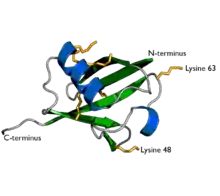Kaufman oculocerebrofacial syndrome
Kaufman oculocerebrofacial syndrome is an autosomal recessive congenital disorder characterized by mental retardation, brachycephaly, upslanting palpebral fissures, eye abnormalities, and highly arched palate.[1][3] It was characterized in 1971;[5] eight cases had been identified as of 1995.[6]
| Kaufman oculocerebrofacial syndrome | |
|---|---|
| Other names | Blepharophimosis-ptosis-intellectual disability syndrome |
 | |
| Kaufman oculocerebrofacial syndrome has an autosomal recessive pattern of inheritance. | |
| Symptoms | Arachnodactyly[1] |
| Causes | Mutation in the UBE3B gene[2] |
| Diagnostic method | Growth assessment, Thyroid function evaluation[3][4] |
| Treatment | Thyroid hormone replacement, Speech therapy[3] |
Symptoms and signs
The signs and symptoms of Kaufman oculocerebrofacial syndrome are consistent with the following:[1][7]
- High palate
- Microcephaly
- Constipation
- Intellectual disability
- Muscular hypotonia
- Nystagmus
Cause
The cause of this condition is apparently due to mutation in the UBE3B gene and is inherited via autosomal recessive manner.[2] This gene is located at molecular location- base pairs 109,477,410 to 109,543,628 and position 24.11 on chromosome 12.[8]
Genetics

The mechanism (or pathogenesis) of Kaufman oculocerebrofacial syndrome appears to begin due to a mutation in the E3 ubiquitin protein ligase. (UBE3B). [9]
One finds that the normal mechanism of UBE3B gene is important in the ubiquitin-proteasome system. The aforementioned system helps to remove proteins that have degraded.[10][8]
However, when not working properly due to the mutation in the UBE3B gene(at least 15 mutations) results in an unstable UBE3B protein which has a negative effect on the ubiquitin-proteasome system.[8]
Diagnosis

The diagnosis of Kaufman oculocerebrofacial syndrome can be achieved via molecular testing approaches. Additionally to ascertain if the individual has the condition:[3][4]
- Growth assessment
- Thyroid function evaluation
- Kidney ultrasound
- Echocardiogram
Differential diagnosis
Kaufman oculocerebrofacial syndrome differential diagnosis consists of:[3]
- Ohdo syndrome
- Smith–Lemli–Opitz syndrome
- Maat–Kievit–Brunner syndrome
- Chromosome 3pter-p25 deletion syndrome
Management
Treatment for this condition entails surveillance of growth and contractures. Furthermore the following are treatment options:[3]
- Thyroid hormone replacement
- Speech therapy
- Hearing aids
See also
References
- "Kaufman oculocerebrofacial syndrome | Genetic and Rare Diseases Information Center (GARD) – an NCATS Program". rarediseases.info.nih.gov. Retrieved 2017-07-29.
- "OMIM Entry - # 244450 - KAUFMAN OCULOCEREBROFACIAL SYNDROME; KOS". omim.org. Retrieved 21 October 2017.
- Basel-Vanagaite, Lina; Borck, Guntram (1993). "Kaufman Oculocerebrofacial Syndrome". In Pagon, Roberta A.; Adam, Margaret P.; Ardinger, Holly H.; Wallace, Stephanie E.; Amemiya, Anne; Bean, Lora J.H.; Bird, Thomas D.; Ledbetter, Nikki; Mefford, Heather C. (eds.). GeneReviews. Seattle (WA): University of Washington, Seattle. PMID 27763745.update 2016
- "Kaufman Oculocerebrofacial Syndrome, Sequencing UBE3B Gene - Tests - GTR - NCBI". www.ncbi.nlm.nih.gov. Retrieved 21 October 2017.
- Kaufman R, Rimoin D, Prensky A, Sly W (1971). "An oculocerebrofacial syndrome". Birth Defects Orig Artic Ser. 7 (1): 135–138. PMID 5006210.
- Briscioli V, Manoukian S, Selicorni A, Livini E, Lalatta F (1995). "Kaufman oculocerebrofacial syndrome in a girl of 15 years". Am J Med Genet. 58 (1): 21–3. doi:10.1002/ajmg.1320580106. PMID 7573151.
- Winter, Robin M.; Baraitser, Michael (2013). Multiple Congenital Anomalies: A Diagnostic Compendium. Springer. p. 327. ISBN 9781489931092. Retrieved 21 October 2017.
- Reference, Genetics Home. "UBE3B gene". Genetics Home Reference. Retrieved 21 October 2017.
- Reference, Genetics Home. "Kaufman oculocerebrofacial syndrome". Genetics Home Reference. Retrieved 2017-07-29.
- Nandi, Dipankar; Tahiliani, Pankaj; Kumar, Anujith; Chandu, Dilip (2006). "The ubiquitin-proteasome system" (PDF). Journal of Biosciences. 31 (1): 137–155. doi:10.1007/bf02705243. ISSN 0250-5991. PMID 16595883.
Further reading
- Pryse-Phillips, William (2009). Companion to clinical neurology (3rd ed.). Oxford: Oxford University Press. ISBN 9780195367720. Retrieved 29 July 2017.
- al.], Victor A. McKusick; with the assistance of Stylianos E. Antonarakis ... [et (1997). Mendelian inheritance in man : a catalog of human genes ... (12. ed.). Baltimore, Md.: Johns Hopkins. ISBN 9780801857423. Retrieved 29 July 2017.
External links
| Classification | |
|---|---|
| External resources |